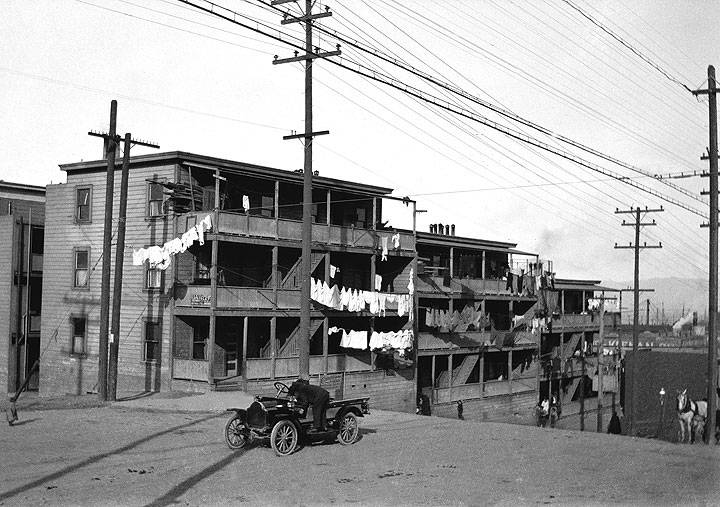North Beach: Little Italy
Historical Essay
The Cuneo Flats at Bay and Leavenworth, c. 1904
Photo: J. B. Monaco
After the 1906 earthquake and fire, Germans, Russians, Eastern Europeans moved out permanently while Italian migration into the neighborhood continued. The Italian influence on North Beach peaked between the two World Wars when over 60,000 of its residents claimed Italian ancestry and five Italian language newspapers circulated the neighborhood. By the 1920s, North Beach was predominantly Italian and known as "Little Italy." A.P. Giannini's Banca d'Italia, later to become known as Bank of America, lent out money on the basis of an individual's reputation in the Italian community. North Beach was the site of the first established Italian hospital in the U.S., and Italians dominated the city scavengers and the teamsters.
After the turn of the century, Italians also formed communities in the Inner and Outer Mission, Excelsior, Bernal Heights, and Potrero Hill where they could work in nearby factories, warehouses, workshops, and railroads. An Italian parish was established in the Mission District in 1898. The first branch of the Bank of Italy also opened in the Mission in 1907.
North Beach's Little Italy began to disperse as early as the 1920's, with particularly successful North Beach residents moving to the more upscale Marina District, leaving behind the cramped apartments of Little Italy. After WWII, larger numbers of Italian families left, typical of the pattern of many of the City's residents, for the roomier and greener suburbs of Marin and the East Bay.
Although North Beach has retained much of its Italian flavor, especially in terms of the restaurants, cafes, and bakeries which attract residents and tourists far and wide, today's residents more reflect the City's diverse polyglot. Large numbers of Chinese families have crossed the Broadway street division (historically Broadway served as a clear and rarely crossed boundary between the two communities) as we see more of a blending of the North Beach and Chinatown neighborhoods. Increasing numbers of Chinese businesses have move into closed Italian storefronts and an increasing number of homes left by deceased older Italians have been purchased by Chinese. A large number of very successful individuals have also been attracted by North Beach's cosmopolitan feel and spectacular views, residing on the slopes of Telegraph and Russian Hill, where the rents are very high. North Beach has gradually evolved into a neighborhood with a multiethnic presence and feel, and reflects one of the more successful and harmonious such transitions in a neighborhood previously identified with primarily one dominant ethnic group.
--courtesy Northern California Coalition on Immigrant Rights, from an immigrant history walking tour conducted Sept. 20, 1997.

